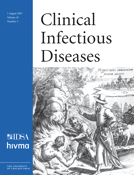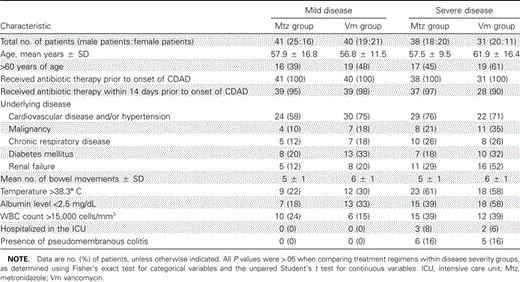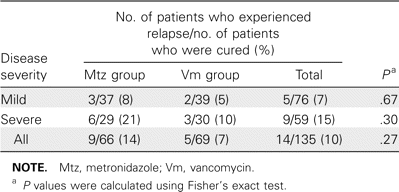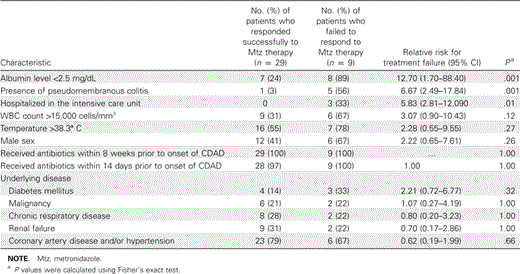-
PDF
- Split View
-
Views
-
Cite
Cite
Fred A. Zar, Srinivasa R. Bakkanagari, K. M. L. S. T. Moorthi, Melinda B. Davis, A Comparison of Vancomycin and Metronidazole for the Treatment of Clostridium difficile–Associated Diarrhea, Stratified by Disease Severity, Clinical Infectious Diseases, Volume 45, Issue 3, 1 August 2007, Pages 302–307, https://doi.org/10.1086/519265
Close - Share Icon Share
Abstract
Background. The incidence and severity of Clostridium difficile–associated diarrhea (CDAD) has been increasing, and there have been recent reports of metronidazole treatment failure. Metronidazole is still commonly used as first-line treatment for CDAD but has never been compared with vancomycin in a prospective, randomized, double-blind, placebo-controlled trial. We conducted such a trial, stratifying patients according to disease severity, to investigate whether one agent was superior for treating either mild or severe disease.
Methods. From October 1994 through June 2002, patients with CDAD were stratified according to whether they had mild or severe disease based on clinical criteria and were randomly assigned to receive oral metronidazole (250 mg 4 times per day) or oral vancomycin (125 mg 4 times per day) for 10 days. Both groups received an oral placebo in addition to the study drug. Patients were followed up for 21 days to assess cure, treatment failure, relapse, or intolerance.
Results. One hundred seventy-two patients were enrolled, and 150 of these patients successfully completed the trial. Among the patients with mild CDAD, treatment with metronidazole or vancomycin resulted in clinical cure in 90% and 98% of the patients, respectively (P = .36). Among the patients with severe CDAD, treatment with metronidazole or vancomycin resulted in clinical cure in 76% and 97% of the patients, respectively (P = .02). Clinical symptoms recurred in 15% of the patients treated with metronidazole and 14% of those treated with vancomycin.
Conclusions. Our findings suggest that metronidazole and vancomycin are equally effective for the treatment of mild CDAD, but vancomycin is superior for treating patients with severe CDAD.
Clostridium difficile is the most common infectious etiology of nosocomial diarrhea in acute care settings, accounting for 15%–25% of all cases of antibiotic-induced diarrhea [1, 2], and the incidence and severity of C. difficile appear to be increasing [3, 4]. Only 2 prospective, randomized trials have compared vancomycin and metronidazole, the antibiotics most commonly used to treat C. difficile–associated diarrhea (CDAD) [5, 6]. Neither trial was blinded or placebo-controlled, and the number of patients enrolled may have limited the ability of the trials to detect a difference in efficacy. To our knowledge, no prospective study has stratified patients on the basis of severity. We report the results of a large prospective, randomized, double-blind, placebo-controlled trial of vancomycin treatment versus metronidazole treatment, stratified by disease severity.
Methods
Study population. Saint Francis Hospital (Evanston, IL) is a 200-bed, acute care teaching hospital affiliated with the University of Illinois at Chicago (Chicago, IL). From October 1994 through June 2002, inpatients with diarrhea were actively recruited into the trial by faculty and hospital staff. Potential study participants were identified from the microbiology lab log books of patients who had stool assays performed for C. difficile toxin. Criteria for inclusion in the study were diarrhea (defined as ⩾3 nonformed stools in 24 h) and C. difficile toxin A demonstrated in the stool within 48 h after study entry or pseudomembranous colitis found on endoscopic examination. Patients could be enrolled if they were clinically suspected to have CDAD, and they were dropped from the study if the toxin A assay result was negative and if no pseudomembranous colitis was demonstrated on endoscopic examination (if performed). All patients were required to have the ability to receive oral medications and give informed consent. Exclusion criteria were the presence of suspected or proven life-threatening intraabdominal complications, including a perforated viscus or bowel obstruction; prior failure of CDAD to respond to either study drug; pregnancy; history of allergy to either study drug; or treatment with oral vancomycin or parenteral or oral metronidazole during the previous 14 days. Patients were not allowed to receive any antidiarrheal medications or drugs with potential activity against C. difficile.
Study design. The study was designed as a prospective, randomized, double-blind, placebo-controlled trial and was approved and monitored by the St. Francis Hospital Institutional Review Board. Patients who experienced onset of diarrhea in the hospital were screened for inclusion and were stratified into mild and severe disease groups based on a severity assessment score developed for this study. Patients with ⩾2 points were considered to have severe CDAD. One point each was given for age >60 years, temperature >38.3°C, albumin level <t;2.5 mg/dL, or peripheral WBC count >15,000 cells/mm3 within 48 h of enrollment. Two points were given for endoscopic evidence of pseudomembranous colitis or treatment in the intensive care unit.
A history of antibiotic use up to 8 weeks prior to the onset of diarrhea and the comorbid conditions of cardiovascular disease (i.e., congestive heart failure or known coronary artery disease), hypertension, chronic respiratory disease (i.e., emphysema, chronic bronchitis, or pulmonary fibrosis), diabetes mellitus, renal failure, and malignancy was obtained. A complete blood cell count, WBC differential, serum creatinine levels, and albumin levels were obtained at study entry and at least every 3 days after study entry. Aerobic bacterial culture of stool samples for Salmonella, Shigella, and Campylobacter species and examination of stool samples for ova and parasites were performed within 48 h after enrollment to exclude other infectious causes of diarrhea. Pregnancy tests were performed for all women aged 15–50 years. Patients were monitored daily to determine the frequency of stools and the first day on which the diarrhea resolved (defined as ⩽2 formed stools in a 24 h period). Daily vital signs and abdominal symptoms were recorded. Patient interviews were performed 21 days after completion of therapy. For patients discharged prior to completion of therapy, interviews were conducted by telephone on days 5, 11, and 21 after completion of therapy. A stool assay was performed for detection of C. difficile toxin A on days 6 and 10 of therapy until a specimen was negative for the toxin; stool samples were also checked on day 21 if diarrhea was present.
Identification ofC. difficiletoxin. Stool specimens were submitted to the St. Francis Hospital Microbiology Laboratory, where they were stored at 4°C and processed within 24 h. The same EIA assay for C. difficile toxin A antigen was used for the duration of the study (Bartels C. difficile Toxin A Antigen EIA with controls; Trinity Biotech).
Treatment regimen. A member of the pharmacy staff randomized participants by selecting a card from a sealed envelope that had 1 of the active study drugs listed on it. Ten cards, 5 labeled with each drug, were used, and the process was repeated for the next 10 participants. A separate set of cards was maintained for each severity group. Patients received either vancomycin liquid (125 mg 4 times per day) and a placebo tablet that was similar in appearance to metronidazole or a metronidazole tablet (250 mg 4 times per day) and an unpleasantly-flavored placebo liquid for 10 days. The liquid placebo was created using a mixture of nontoxic inert diluents and small quantities of liquid vitamins.
Assessment of efficacy. The primary outcomes assessed were cure, treatment failure, and relapse. Cure was defined as resolution of diarrhea by day 6 of treatment and a negative result of a C. difficile toxin A assay at days 6 and 10 of treatment. Treatment failure was defined as persistence of diarrhea and/or a positive result of a C. difficile toxin A assay after 6 days of treatment, the need for colectomy, or death after 5 days of therapy. Relapse was defined as recurrence of C. difficile toxin A–positive diarrhea by day 21 after initial cure.
Intolerance was defined as the inability or refusal to continue the medication because of adverse reactions. Noncompliance was defined as missing >3 doses of the study medication during the 10 days of therapy for reasons other than intolerance.
Assessment of adverse reactions. Adverse reactions were assessed by a daily history and physical examination, a complete blood cell count, and a chemistry panel every 3 days until study completion.
Statistical design and analysis. The study was powered using a 2-tailed β of 0.05 and a α of 0.10, with the assumption of a 90% cure rate in each group, in an attempt to detect a minimum difference of 10% in the treatment groups. On the basis of this assumption, we concluded that we would need to have 150 patients complete the trial. With the assumption of a 10% drop-out rate, we thus attempted to enroll at least 166 patients. The study was eventually terminated, and the treatment code was broken, when the primary investigator (F.A.Z.) left the institution. Outcomes, with respect to study drug and severity of disease, were compared using Fisher's exact test or the unpaired t test. Assessment of optimal study size and performance of statistical tests was conducted using InStat for Macintosh, version 2.03 (GraphPad Software).
Results
Randomization and study completion. One hundred seventy-two patients were randomized: 90 had mild disease, and 82 had severe disease. Twenty-two patients were withdrawn from the study prior to completion of 10 days of therapy. Nine of these patients had mild disease, 5 of whom were randomized to receive metronidazole treatment (1 died within 5 days of treatment, 1 was intolerant of therapy, and 3 were lost to follow-up), and 4 of whom were randomized to receive vancomycin treatment (1 was noncompliant, 1 was intolerant of therapy, and 2 were lost to follow-up). Thirteen patients with severe disease were withdrawn from the study, 6 of whom were randomized to receive metronidazole treatment (4 died within 5 days of treatment, 1 was noncompliant, and 1 was lost to follow-up), and 7 of whom were randomized to receive vancomycin treatment (3 died within 5 days of treatment, 2 were noncompliant, 1 was intolerant of therapy, and 1 was lost to follow-up).
Of the 150 patients who completed the trial, 81 had mild disease (41 received metronidazole therapy, and 40 received vancomycin therapy), and 69 had severe disease (38 received metronidazole therapy, and 31 received vancomycin therapy). Baseline characteristics are shown in table 1. There were no significant differences between patients randomized to receive metronidazole therapy or vancomycin therapy when compared within severity groups.
Baseline characteristics of patients with Clostridium difficile–associated diarrhea (CDAD), by disease severity and treatment.
Treatment outcomes. The overall rate of cure was 84% (66 of 79 patients) in the metronidazole group and 97% (69 of 71 patients) in the vancomycin group (P = .006) (table 2). Among the patients with mild disease, treatment resulted in clinical cure in 37 (90%) of 41 patients treated with metronidazole and in 39 (98%) of 40 patients treated with vancomycin (P = .36). Among the patients with severe disease, treatment resulted in clinical cure in 29 (76%) of 38 patients treated with metronidazole and in 30 (97%) of 31 patients treated with vancomycin (P = .02).
Rate of cure of Clostridium difficile–associated diarrhea by disease severity and treatment.
Relapse of disease occurred after initial cure in 5 (7%) of 76 patients with mild disease and in 9 (15%) of 59 patients with severe disease (P = .15). Relapse of disease occurred after initial cure in 9 (14%) of 66 patients treated with metronidazole and in 5 (7%) of 69 patients treated with vancomycin (P = .27) (table 3).
Rates of relapse of Clostridium difficile–associated diarrhea by disease severity and treatment.
Adverse reactions leading to discontinuation of therapy. One patient in each treatment group elected to discontinue receiving the active study drug. One patient randomized to receive metronidazole therapy experienced emesis and was switched to vancomycin therapy, resulting in cure. Another patient experienced nausea while receiving vancomycin therapy and was switched to metronidazole therapy, resulting in cure. In no other cases were the study drugs implicated in adverse reactions that caused the patients, treating physicians, or investigators to change or discontinue the study drugs.
Factors associated with metronidazole treatment failure in patients with severe CDAD. We analyzed the characteristics of patients treated with metronidazole who had severe CDAD with respect to whether they had successful clinical outcome (table 4). The characteristics that were statistically more common in the patients who experienced metronidazole treatment failure were a low albumin level, admission to the intensive care unit, and the presence of pseudomembranous colitis on endoscopic examination.
Characteristics of patients with severe Clostridium difficile–associated diarrhea (CDAD) with respect to response to metronidazole therapy.
Discussion
There have been 2 prospective, randomized trials comparing the efficacy of metronidazole and vancomycin for the treatment of CDAD. Teasley et al. [5] randomized 94 patients to receive vancomycin or metronidazole therapy and demonstrated a 95% cure rate for patients who received metronidazole therapy, compared with a 100% cure rate for patients who received vancomycin therapy; the results did not reach statistical significance. Wenisch et al. [6] randomized 31 patients to receive metronidazole or vancomycin therapy (as well as 29 patients to receive fusidic acid therapy and 28 patients to receive teicoplanin therapy). The cure rates in the metronidazole and vancomycin groups were both 94%. Neither of these studies was blinded, and no attempt was made to stratify patients according to disease severity. Because of the small number of patients assessed in each study, these trials may not have been powered sufficiently to detect a significant difference between the treatments.
At the time of design of our study, there was little published data with respect to risk factors for severe disease or recurrence. Subsequent to our study, several studies had attested to the validity of many of the risk factors that were chosen, including increasing age [7,8–9], leukocytosis [8,9,10,11–12], a low serum albumin level [11, 13,14–15], and hospitalization in the intensive care unit [13]. Additional risk factors identified by other authors have included duration and/or number of offending antibiotics [14,15–16]; intercurrent cancer, chronic obstructive pulmonary disease, immunosuppression, antiperistaltic medications, abdominal pain or tenderness, or hemoconcentration [11]; renal failure [9, 11, 12]; decreased quality-of-life index [7]; duration of hospitalization [9]; community-acquired [12] or nursing home–acquired [17] disease; acquisition during the spring, prior episodes of CDAD, or female sex [16]; and decreased mental status and recent endoscopic examination [18].
Because metronidazole is less expensive and vancomycin has the potential to increase the prevalence of vancomycin-resistant organisms, metronidazole has been commonly recommended as first-line therapy [19,20–21]; however, suggestions have been made that vancomycin therapy may be used for severe or refractory cases [19,20,21,22,23–24], and 1 study revealed a trend toward lower incidence of complications when vancomycin was the initial therapy [9]. Interestingly, despite these widely published recommendations, >25% of infectious disease physicians who were recently surveyed use vancomycin as initial therapy for CDAD [25].
Our study was the first randomized, prospective, double-blind, placebo-controlled trial of vancomycin versus metronidazole for the treatment of CDAD and revealed that vancomycin therapy was superior to metronidazole therapy overall, but the treatment benefit was limited to patients with severe disease. This conclusion is timely because of the newly described hypervirulent epidemic strain of C. difficile, which is NAP1, ribotype 027, and toxinotype III and produces a binary toxin [26, 27]. Many of these strains have an altered tcdC gene, which modifies the TcdC protein that is a putative negative regulator of toxin A and toxin B production. These strains have been shown to produce toxin levels that are 16–23-fold greater than wild-type strains [28] and have been associated with more-severe disease [4, 8, 10, 29], an increased number of relapses after metronidazole therapy [8, 30], and occurrence of disease in previously uncommon populations, such as outpatients, peripartum women, children, and persons who have never received antibiotics [31, 32].
Our study did not allow us to determine why metronidazole treatment failure occurred more frequently in patients with severe disease. Although we did not perform culture to obtain strains of C. difficile for susceptibility testing, we do not think that resistance to metronidazole was the reason for treatment failure. Although metronidazole resistance has long been known [33], and although there is an increasing incidence of reported metronidazole treatment failures [8, 30], resistance does not appear to be increasing [34]. In addition, if high-level resistance to metronidazole was the cause of treatment failure, it should have contributed to treatment failure in both patients with mild disease and patients with severe disease.
A potential mechanism for our observation that metronidazole performs less well in patients with severe disease is that the drug is delivered from the bloodstream through the inflamed colonic mucosa, and stool concentrations decrease as disease resolves [35]. We hypothesize that patients with severe disease may have decreased blood flow to the colon and, therefore, deliver less metronidazole to the mucosa and the colonic lumen.
In an attempt to decrease the spread of vancomycin resistance, specifically among enterococci, vancomycin is not currently recommended as first-line therapy for CDAD by the Centers for Disease Control and Prevention [36]. Although vancomycin use is clearly a risk factor for selection of vancomycin-resistant enterococci [37, 38], other studies suggest that metronidazole may be a similar risk factor [39, 40]. We did not perform an assay among our patients for colonization with vancomycin-resistant enterococci.
In summary, we have shown that vancomycin is superior to metronidazole for the treatment of severe CDAD. This may require a modification of treatment guidelines for CDAD, especially because of the increasing prevalence of an epidemic strain that is producing more-severe disease.
Acknowledgments
Potential conflicts of interest. All authors: no conflicts.









Comments